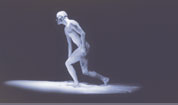|
Ethymology:
bu-yoh traditional
japanese dance
bu-toh
stamping dance
background:
Butoh is a contemporary avant-garde post-war dance form, which originated in Japan and which was first performed there in 1959. It combines dance, theater, improvisation and influences of Japanese traditional performing arts with German Expressionist dance (Neuer Tanz) and performance art to create a unique performing art form that is both controversial and universal in its expression. It has evolved to become an international art form with artists and groups devoted to teaching and performing it in East and South-East Asia, North and South America, Europe, Australia, New Zealand and Hawaii.
birth of
Butoh:
May 1959: Performance Kinjiki by Tatsumi Hijikata: It was a short piece, without music, and it raised a scandal. In the piece a young boy (Yoshito Ohno) enacted sex with a chicken by strangling it between his thighs. In the darkness that followed a man - Tatsumi Hijikata - approached the boy.
1959 bis
1968
The time of Ankoku Butoh
The word Ankoku Butoh - later abbreviated to butoh - was introduced by Hijikata. It means Dance of Darkness. The best thing is to describe it as a mixture of elements of traditional Japanese theatre, Ausdrucktanz and mime. It breaks with the established (dance) rules and leaves much room for improvisation. Characteristics one often sees are the white painted bodies, the slow movements, the bold heads and contorted postures. The dance evokes images of decay, of fear and desparation, images of eroticism, ecstasy and stillness.
1968
Rebellion of the body: the next marking performance of Hijikata
70
er Jahre:
the most important japanes butoh artists work abroad, because in japan they can only work in the underground:
f.e.Ushio Amagatsu, Min Tanaka, Anzu Furukawa,
Mitsutaka Ishi, Ko Murobushi und Carlotta
Ikeda leave their home country and go to europe
1977
Admiring La Argentina, the most famous performance of Kazuo Ohno
(now 71 years old, >>>> installing the white butoh
international break through of butoh
1985
First Butoh- dance festival in Japan
1986
Hijikata dies
at the present time
butoh is present all over the world, as a dance, as a method of therapy, as a method of teaching acting students, as a timeless expression of the body.
Literature:
Butoh, Die Rebellion des Körpers,
Ein Tanz aus Japan,
Michael Haerdter und Sumie Kawai,
Alexander Verlag Berlin 1986
Die Enstehung des Butoh, Lucia Schwellinger,
iudicium Verlag GmbH München,
1998
|



